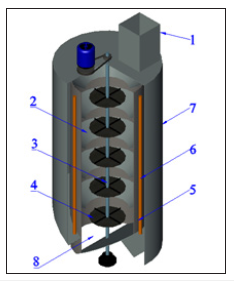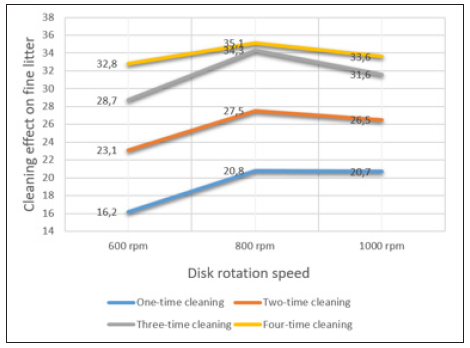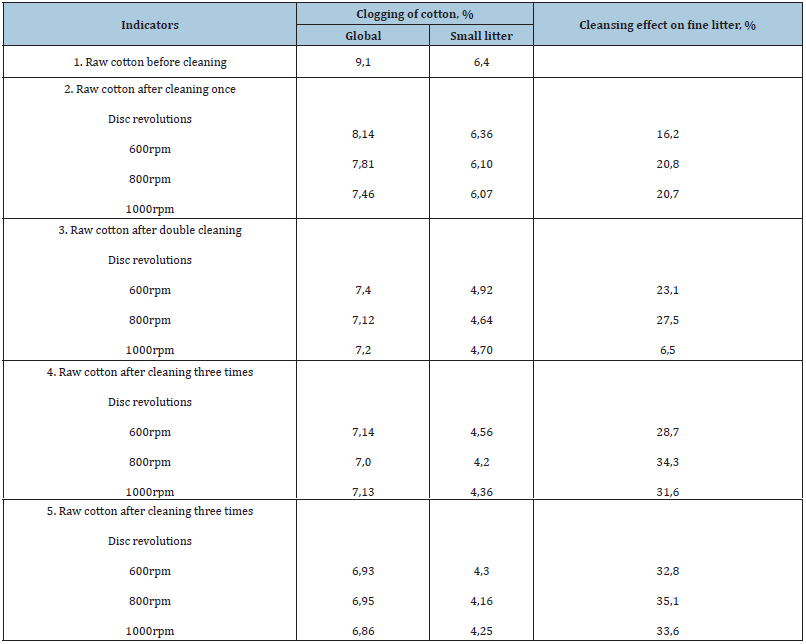- Submissions

Full Text
Evolutions in Mechanical Engineering
Innovative Drying and Cleaning Unit for the Modernization of the Technology of Primary Processing of Cotton
Mirkhosil Agzamov1*, Mirsolikh Agzamov2 and Khasan Nosirov3
1Department of Technological Machines and Equipment, Tashkent Institute of Textile and Light Industry, Uzbekistan
2Senior Researcher of department of “Labor and Environmental Protection”, Uzbekistan
3Researcher, Master of department of “Technological Machines and Equipment”, Uzbekistan
*Corresponding author:Mirkhosil Agzamov, PhD, Assistant of department of “Technological Machines and Equipment”, Tashkent Institute of Textile and Light Industry, Uzbekistan
Submission: October 25, 2021;Published: January 26, 2022

ISSN 2640-9690 Volume4 Issue1
Abstract
In article reflected feasibility study of conducting research on technological development of cotton primary processing with the modified parameters of drying and cleaning process for small litter. As a result of theoretical and experimental research, drying and purifying unit is designed, in which in the existing processes a heat source, exhaust fans, a dryer drum, a peg-drum cleaner of cotton and the vehicle transmitting raw cotton from the dryer to the purifier will be excluded. The experience has shown that when a drying-purifying unit is installed (with eight wheels) purifying effect on the small litter of 34%, i.e., cleaning effect is higher than of that currently in operation 1XK drum cleaner.
Keywords:Drying and cleaning unit; Heat generator; Smoke exhauster; Drum dryer; Peg-drum cleaner; Cleaning effect; Ginning; Pressing; Heat carrier; Overdrying of fiber and seeds
Introduction
Every year in the world market, the demand for cotton fiber is increasing, and the production of cotton fiber is also growing to meet the demand. At the same time, in recent years, the production of cotton fiber in our republic has been gradually decreasing. From the graphical data shown in Figure 1, it can be seen that the volume of fiber production for the 2018-2019 crop was 700 thousand tons and the republic took seventh place in world production.
Figure 1:Volume of fiber production for the 2018-2019. (Source: Ministry of agriculture of USA)

In the Republic of Uzbekistan for 2017-2021, it is envisaged to “increase the competitiveness of the national economy, reduce energy and material costs in the economy, and widely introduce energy-saving technologies into production.” The tasks set are being solved on the basis of the widespread introduction of new technology, the use of advanced and perfect technology, the comprehensive mechanization of production processes, and the technical re-equipment of industry.
In the current conditions, one of the main ways to increase production efficiency is the technical re-equipment of the industry’s enterprises, with the introduction of the latest achievements of science and technology into production. Selected varieties of raw cotton, such as An-Bayaut 2, Andijan 35, Bukhara 6, Namangan 77, C-4727 and C-6524, are mainly grown in the republic [1].
Processing of raw cotton is carried out at cotton processing plants. There are about a hundred cotton processing plants in the country. The technological process of primary processing of cotton in Uzbekistan consists of several stages and uses a number of vehicles and technological machines. At the beginning of the process, the raw cotton is dried in a drying drum, after that, with the help of a separator, it is fed into the cotton ginning machines, in which it is cleaned of small and large trash impurities. The raw cotton, cleaned from small and large trash impurities, is conveyed by means of air transport to the distribution auger, which distributes the raw cotton to the gins. In it, the fibers are separated from the seed. With the help of a condenser, the fiber is fed into a press, in which it is pressed into bales, and the seeds of raw cotton are transferred to a linter machine by means of an auger. The linter machine separates the remaining short fibers (lint) from the raw cotton seed.
Currently, drying of raw cotton has a rather long drying time, which leads to over drying not only of the fiber, but also of cotton seeds, and in addition to unnecessary consumption of electricity and fuel. Overdrying the fiber can have a positive effect in the process of cleaning raw cotton from weeds, because dried fiber is better cleaned from weeds, but over drying the seeds has a negative effect in the ginning process.
Analytic part
As shown by numerous studies carried out by various leading scientists in the direction of drying raw cotton (AP Parpiev, MA Akhmatov, MA Gapparova, AK Usmankulov and others [2-6]) at present time in the cotton ginning industry in Uzbekistan, the drying process is still ineffective and highly energy-consuming. The available information on previous studies of the drying process showed that all studies were carried out mainly in a narrow direction, only the drying process itself or the design of dryers were studied. The technological regulations for the primary processing of cotton applied in practice were drawn up without taking into account the above facts, since previously no scientific research has been carried out to study the influence of the drying time of raw cotton on the subsequent transitions of the technological process and, most importantly, the ginning and pressing process. There is no information about scientific research carried out abroad in this direction.
Earlier, JSC “Pakhtasanoat ilmiy markazi” developed methods for the experimental determination of the strength and breaking force of the seed coat in laboratory conditions. These methods can serve as the basis for the development of new methods for determining the influence of the drying time of raw cotton on the strength of the seed skin, the strength of fiber attachment to the seed, and the development of bench installations for the experimental determination of the effect of drying time on the performance of the ginning process. Thus, it can be noted that this problem has not been studied before and has no world analogues.
It has been established that the 2СБ-10 type direct-flow drum dryers (Figure 2) have the following disadvantages:
Figure 2: General view of the drum dryer 2СБ-10.

1. The dried raw cotton is unevenly distributed along
the length and cross-section. Areas free from raw cotton are
formed, through which the incoming heat carrier leaves the
dryer in transit, and this leads to a significant loss of heat.
2. The heat carrier is unevenly distributed along the length
and cross-section of the drum. Its average speed, if at the
entrance to the drum, is 7-8m/s, then at the last meters of the
drum it drops to 0.1-0.4m/s.
3. The design of the dryer drum limits the speed of the
incoming heat carrier into the chamber. In order to prevent the
entrainment of the incoming wet raw cotton along the drum,
the speed of the heat carrier is maintained within 0.6-1.5m/s.
The boundary layer formed on the surface of the wet material creates an obstacle to heat transfer. The speed of the incoming coolant (0.6-1.5m/s) is insufficient for turbulization of the boundary layer [7]. In this regard, heat is transferred to the material only by the thermal conductivity of the layer, which affects the slowdown of the process of heat and moisture exchange. The minimum residence time of the raw cotton in the drum is 5-6 minutes, while the time for falling of the raw cotton from the blades is only 1.0-1.5 minutes. The rest of the time, raw cotton is in the passive drying zone, that is, in the lifting zone on the blades.
As you know, at the moment in the technological process of the primary processing of cotton, the drying time is not regulated, although this indicator has a significant impact on the quality indicators of the final product - cotton fiber and cotton seeds. Drum dryers are used as cotton dryers. Inside the dryer, raw cotton is dried for up to 6-10 minutes.
When the fiber and seeds are overdried, their fragility increases, especially of the seed rind. As a result, during the ginning process, the shortening of the fiber increases, which reduces the spinning and technological properties and naturally leads to a decrease in the value of the fiber. The hairiness of the seeds grows after the gin due to the fact that the fiber does not break off from the seed peel but breaks at the bend at the saw tooth. When the fiber is detached from the seed, as a result of the fragility of the seed peel, the seed peel is destroyed and, as a result, the formation of fiber defects - peel with fiber and broken seeds, grows, which leads to a decrease in the quality of the fiber by several classes. The destruction of the seed coat also leads to a deterioration in the quality of the seed. Prolonged heating also leads to drying out of the seed kernel, which negatively affects the germination of the seed seeds and can affect the oil yield of industrial seeds. Overdrying the fiber also has a negative effect on the pressing process. Due to the high elasticity of the fibers, the bales of the fibers are lightweight, which leads to overspending of packaging materials and underloading of wagons and to frequent destruction of the strapping belts.
Based on all of the above, it can be argued that the current technological regulations require serious modernization using the results of scientific research to study the influence of the drying time of raw cotton on the ginning process, which will allow: to reduce the consumption of electricity, fuel and fiber loss, improve the quality of the products produced.
Materials and Methods
The purpose of these scientific studies is to develop an upgraded technology for the primary processing of raw cotton, which will reduce the consumption of electricity, fuel, as well as product losses, and improve the quality of the products produced.
To implement this program, it was envisaged to carry out theoretical and experimental studies, both in laboratory and in production conditions, the development of new methods for setting up unique laboratory studies to determine the change in the force of separation of the fiber from the seed peel, depending on the drying time, design and manufacture of special laboratory bench installations. As part of this work, a drying and cleaning unit has been developed (Figure 3), when used, which will exclude a heat generator, a smoke exhauster, a drum dryer, a peg-drum cleaner for raw cotton and a vehicle that transfers raw cotton from the dryer to the cleaner from the existing process [8].
Figure 3: New cleaning and cleaning unit. 1-shaft; 2-guide; 3-rod; 4-disc; 5-shell; 6-heating element; 7-casing; 8-tray.

The drying and cleaning unit works as follows: The fibrous material in the feeder from the shaft 1 by means of the feed rollers (not shown in the figure) through the guide 2 is evenly fed to the disc 4, which is constantly rotating by means of an electric motor, on the rod 3. Under the action of centrifugal force, the fibrous material is ejected from the disc 4 at a certain speed (depending on the number of revolutions of the rod 3) onto the perforated surface of the shell 5. The mass and windage of the fibrous material and trash impurities differ from each other, therefore they receive different speeds when ejected, as a result they are intensively loosening. When moving from the disc 4 to the shell 5, the processed material is blown by a thermal agent supplied to the inside of the perforated shell 5 from the heating elements 6 through the shell perforations; in the final phase of flight, the fibrous material hits the perforated surface of the shell 5.
As a result of the impact of the loosened fibrous material on the perforated surface of the shell 5, there is an intensive release of trash into the annular space formed between the shell 5 and the stationary cylindrical casing 7 fixed to the frame, and from there they are sent to non-returnable waste. The cleaned fibrous material from the perforated surface is rolled onto the tray 8, through which it is fed to the next disc, on which the process described above is repeated. To exclude the occurrence of fibrous material, the trays are installed at an inclination of at least 55° to the plane of the disc 4. The cleaned and dried material is discharged from the drum from below through the branch pipe. The spent (saturated with water vapor) thermal agent from the upper part of the annular space formed between the shell 5 and the stationary cylindrical casing 7 is discharged for disposal.
A block diagram of the automatic temperature control system in the drying and cleaning unit has been developed (Figure 4). The algorithm of the temperature control process inside the drying and cleaning unit is as follows:
Figure 4:A block diagram of the automatic temperature control system in the drying and cleaning unit.

On the scale of the “center” of processing the signal coming from the temperature sensors and giving a signal to the actuator to turn the heating elements on or off, the level of the required maximum and minimum temperatures is set depending on the initial moisture content of the raw cotton.
The power supply of the heating elements turns on. Upon reaching the maximum temperature inside the unit, a signal is sent from the temperature sensors to the “Center” for signal processing, which gives a command to the actuator to turn off the heating elements. After that, the temperature inside the unit starts to decrease. Upon reaching the minimum temperature, according to the signal from the temperature sensors, the “Center” of signal processing, gives a command to the actuator to turn on the heating elements. and thus, the process is constantly repeated.
Result and Discussion
Research has been carried out to determine the efficiency of cleaning from small trash impurities. Table 1 shows the results of studies to determine the cleaning effect of fine trash impurities of the drying and cleaning unit. Analysis of the data in the graph shown in Figure 5 shows that when installed in a drying and cleaning unit (with eight discs), the cleaning effect on fine litter can be 34%, i.e., the cleaning effect is higher than that of the 1XK drum-type cleaner, which is currently in operation. The specified cleaning effect is achieved due to the impact of raw cotton flying off the rotating disc under the action of centrifugal force on the mesh surface, through the holes of which fine litter is sifted. According to the research results, the RUz patent UZ FAP 00674 “Device for drying and cleaning fibrous materials” was obtained.
Figure 5: Graph of the influence of the frequency of cleaning and the number of revolutions of the discs of the cotton-cleaning unit on the cleaning effect of fine litter.

Table 1:

Conclusion
i. As a result of theoretical and experimental studies, a
drying and cleaning unit has been developed, using which the
heat generator, smoke exhauster, drum dryer, peg-drum cleaner
of raw cotton and a vehicle transferring raw cotton from the
dryer to the cleaner will be excluded from the existing process.
ii. The studies carried out have shown that when installed in
a drying and cleaning unit (with eight discs), the cleaning effect
on fine litter is 34%, i.e., the cleaning effect is higher than that
of the currently operated 1XK drum cleaner.
iii. Preliminary calculations of economic efficiency show
that it will amount to more than 100 million sums (about 10
thousand USA dollars) per cotton plant per year, contribute
to the improvement of the ecological situation and working
conditions.
References
- Agzamov MM, Yunusov SZ, Gafurov JK (2017) On the technological development of cotton primary processing, using a new drying-purifying unit. IOP Conf Ser: Mater Sci Eng 254: 082017.
- Parpiev AP, Mamatov AZ and Khudoiberdiev S (2007) The numerical solution of problem of temperature fields determination of cotton flying detachments components. Textiles problems chapter 1, Tashkent, Uzbekistan, pp. 124-28.
- Mamatov AZ (1995) Сotton drying technology modeling to improve the fiber quality. Diss for the degree of Doctor of Science, Tashkent, Uzbekistan, p. 248.
- Gapparova MA (1999) Improving cotton drying process in a tumble dryer to maximize preservation of fiber quality. Diss. for the degree of PhD, Tashkent, Uzbekistan, p. 162.
- Mamatov AZ, Pardaev KhN, Mardonov J Sh, Plekhanov AF (2021) Determining of the heat-moisture state of raw cotton in a drum dryer. Izvestiya Vysshikh Uchebnykh Zavedenii, Seriya Teknologiya Tekstil'noi Promyshlennosti 391(1): 46-49.
- Usmonkulov AK (2001) Influence of Carioles inertial forces on the sliding mass of raw cotton on the surface of the blade of the drying drum. Herald TSTU chapter 2, Tashkent, Uzbekistan, pp. 21-23.
- Parpiev AP (1990) Fundamentals of complex problem solving of fiber quality saving and increased productivity in the pre-processing of raw cotton. Diss. for the degree of Doctor of Science, Tashkent, Uzbekistan, p. 450.
- Agzamov MM (2013) Drying and cleaning unit. Tashkent, Uzbekistan, Patent FAP 00972 Uz, MPK 8 B 01 B1/00 C-9.
© 2022 Mirkhosil Agzamov. This is an open access article distributed under the terms of the Creative Commons Attribution License , which permits unrestricted use, distribution, and build upon your work non-commercially.
 a Creative Commons Attribution 4.0 International License. Based on a work at www.crimsonpublishers.com.
Best viewed in
a Creative Commons Attribution 4.0 International License. Based on a work at www.crimsonpublishers.com.
Best viewed in 







.jpg)






























 Editorial Board Registrations
Editorial Board Registrations Submit your Article
Submit your Article Refer a Friend
Refer a Friend Advertise With Us
Advertise With Us
.jpg)






.jpg)













.bmp)
.jpg)
.png)
.jpg)














.png)

.png)



.png)






